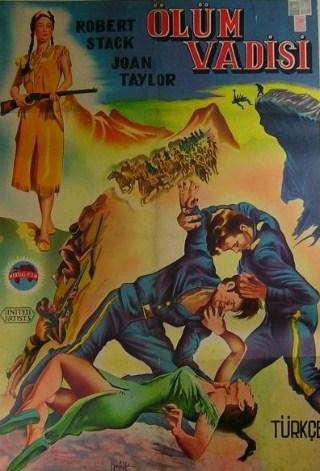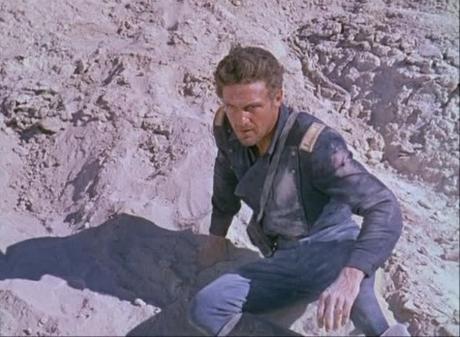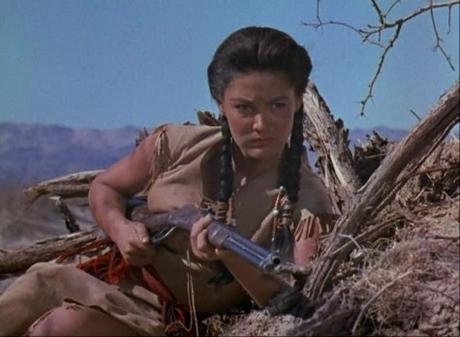
It’s a pity the way low budget programmers, and those who made them, tend to get less critical attention and respect than their more expensive cousins. The result of this is that very good movies get lost in the shuffle and find themselves ignored as both the passage of time and the big name productions shunt them aside. I think Lesley Selander was a solid and skillful filmmaker, with a habit of turning out interesting and well crafted material, yet his name is unknown outside hardcore film buff circles. War Paint (1953) is one of those fairly obscure Selander westerns that highlights his strengths as a director.
The story concerns a treaty between the US government and an unnamed Indian tribe, one of those documents laboriously hammered out and promising peaceful co-existence between the two warring sides henceforth. In this case the agreement has been struck, and the document signed and sealed. The issue, however, is one of delivery. What we’re looking at here is a race against time to ensure the document in question is handed over to the native chief before nine days have passed and the deadline expires. The responsibility lies with one Lieutenant Billings (Robert Stack) and his small patrol. Initially, he’s tasked with handing the treaty over to the local Indian agent, but he’s not going to turn up as his body is lying somewhere out in the wilderness. Instead, it’s this man’s killer, Taslik (Keith Larsen), who also happens to be the chief’s son, that appears. Hitchcock always maintained that a good way to build up suspense was to make sure the audience knows a little more than the protagonists on screen, and that’s how it is in War Paint. While Billings and his troopers believe Taslik is leading them across the parched landscape towards his father’s village, the viewer knows that he has other plans in mind. Bit by bit, the suspicions of the weary and weakening men are roused as the desperately needed water remains elusive and the instances of ill-fortune start to add up.

What kind of words best sum up a Selander picture? Well, toughness and economy spring to mind right away, and War Paint provides an object lesson in both. The movie opens with a cagey and sparse duel among the desert dunes – one man is first blinded and then gunned down while his partner is shot dead and his corpse scalped. This brutal little prologue sets the tone for the gritty story that subsequently plays out. On the surface, we get a solid outdoor adventure with the harsh Death Valley locations providing the backdrop for this man versus nature affair, and it’s very successfully executed even if it’s approached on that basis alone. Still, the more interesting films always have a little more going on to divert us, and War Paint adds some depth by fleshing out the characters – cavalrymen and natives alike – and affording us glimpses of their lives outside the events of the narrative. What we get is one of those microcosmic snapshots, where the hopes, dreams, disappointments and weaknesses of a random selection of humanity is laid before us.
I’ve looked at several examples of what can be referred to as the pro-Indian cycle of 50s westerns on this site before and in doing so I’ve become more aware not only of the number of such movies but also their range and position on the spectrum in terms of sympathy expressed. War Paint hits somewhere around the middle of this imaginary scale, striving for balance and the honesty that accompanies it. I think the exclusively outdoor setting helps with this, stripping away the trappings and distractions of civilization to let us look at things as they really are in the frank and merciless glare of the desert sun. The positive and negative aspects of these two rival cultures are put in front of us and we’re encouraged to appraise each one, taking into account the deceits and betrayals as well as the largess and nobility both are capable of.

Robert Stack didn’t feature in a huge number of westerns – he’s always going to be best remembered as television’s Eliot Ness and for his hilarious turn in Airplane! – but did make some and I think he had the kind of presence that worked well enough in the genre. As Lieutenant Billings, there’s an uncompromising, driven aspect to his character, the kind of thing which is to be seen in a lot cavalry officer parts. Such characteristics aren’t always explained adequately – frequently we’re just asked to accept that this is the way it is – but the writing in War Paint is again deserving of some praise for the way enough expository back story is sprinkled throughout the script to justify motivation and attitude. And this isn’t restricted to Stack; we discover little pieces of background information to round out the character of Joan Taylor’s vengeful young Indian woman and also that of Keith Larsen as her brother. Charles McGraw was able to put his gruffness to use either as a villain or as a good guy, and got to indulge in the latter here as the faithful sergeant always backing up his boss even when he’s wrestling with internal doubts. There’s good support from the likes of Walter Reed, Douglas Kennedy and John Doucette, and some patented nastiness from Peter Graves and Robert J Wilke.
War Paint has been available on DVD for some time now, both as a MOD disc from the US and as a (now rather pricey) pressed disc from Sony/Feel Films from Spain. That Spanish disc looks fairly good, the image is sharp and colorful for the most part but there are some softer and less defined sections and inserts. The film could probably use a bit of a clean up overall but, realistically speaking, this is not the kind of title where the potential sales would justify the expense of such an undertaking. There’s a choice of the original English audio or a Spanish dub and the optional Spanish subtitles can be deselected either via the menu or on the fly from the remote. The trailer is included as an extra feature. This is an enjoyable film, as tight and rugged as you might expect from Selander and attractively shot on location – there’s not a single interior scene. It works on multiple levels and has the kind of maturity of outlook that characterizes the best of the genre’s output in the 50s. It gets my recommendation.
